Category: General
Idaho Army National Guard deploys to Southwest Asia
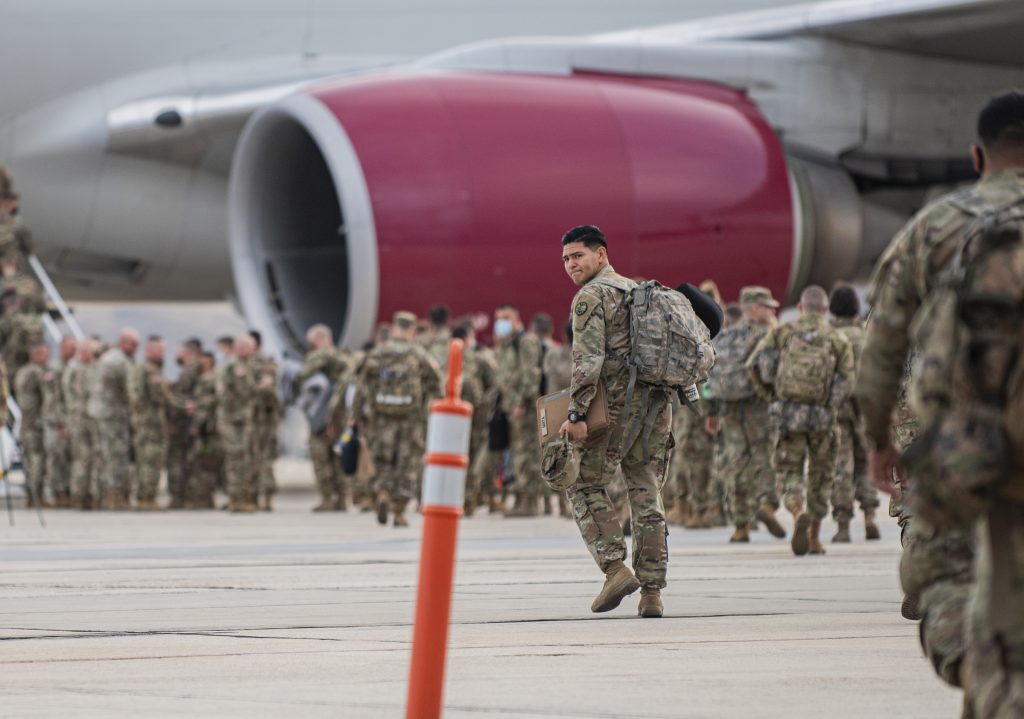
More than 250 Soldiers from the Idaho National Guard’s largest unit, the 116th Cavalry Brigade Combat Team, left for a 12-month deployment on Nov. 5 to Southwest Asia in support of Operation Spartan Shield. The brigade has trained for more than a year in anticipation of this mobilization.
OSS is a joint mission under the United States Central Command and is part of Operation Enduring Freedom. Idaho Soldiers will comprise nearly 20 percent of the 116th CBCT task force during this rotation. Soldiers from 116th CBCT units in Montana, Nevada and Oregon, as well as the Florida Army National Guard, will also fall under the task force.
“The Soldiers of the 116th are trained and ready to go,” said Lt. Col. Eric Orcutt, 116th CBCT commander. “I could not be more proud of these men and women and the efforts they’ve put forth in training and preparing for this mission. They are eager and they are focused and as always, they will achieve the highest level of success.”
OSS is an ongoing operation and supported primarily by Army National Guard units from across the country. This deployment is anticipated to last approximately 12 months and is the first rotation the brigade is scheduled to support, with the second rotation occurring in the summer of 2022. The Soldiers mobilizing today will receive 45 days of additional training stateside before deploying overseas.
The 116th Cavalry Brigade Combat Team previously deployed in support of the Global War on Terror in 2004 and 2010 to Iraq. Additionally, more than 400 Idaho Air National Guardsmen deployed to Southwest Asia in the summer of 2020.
COVID response prompts Idaho National Guard to establish first dual-status commander
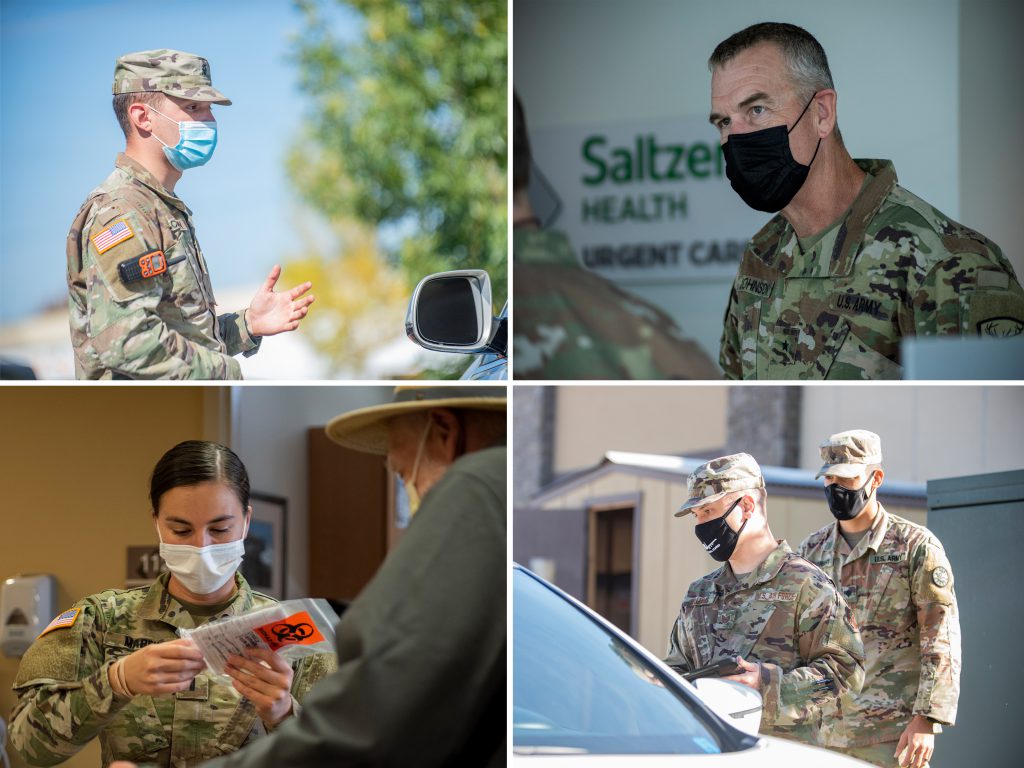
Idaho Military Division Public Affairs/Crystal Farris
In September, after a second wave of COVID-19 cases spread across Idaho, Gov. Brad Little authorized the mobilization of up to 150 Idaho National Guard Soldiers and Airmen. He also requested additional federal support as a last-ditch effort to avoid activating a statewide crisis standards of care—a first in Idaho’s history.
On Sept. 7, at the recommendation of Gov. Little and the Adjutant General of Idaho Maj. Gen. Michael Garshak, U.S. Northern Command appointed Brig. Gen. Russ Johnson, Idaho National Guard director of joint staff, as the state’s first-ever dual-status commander. That same day, Idaho Guardsmen and federal active duty military personnel began reporting to hospitals, clinics and other medical facilities across the state in support of overwhelmed medical staff.
“Joint Task Force – Idaho is helping free up civilian medical staff allowing them to focus on providing medical care during the ongoing surge in COVID-19 cases,” said Johnson. “Collectively, our Title 32 Idaho National Guardsmen and Title 10 active duty personnel are employed in direct support of our healthcare sector, making a difference in the lives of Idaho citizens every day.”
Currently, Idaho National Guardsmen are serving at nearly two-dozen healthcare facilities across the state performing non-clinical duties including medical screenings, testing collection, logistics assistance and other administrative tasks.
Idaho National Guard Col. Britt Vanshur, chief of the joint staff, said the Idaho National Guard provides support in administrative functions rather than playing a clinical role, since the majority of its medical professionals are part-time Guardsmen already working full time at hospitals, clinics and healthcare facilities.
“It would be imprudent to pull our Idaho Guard medical personnel from their civilian capacities at these healthcare facilities just to activate and send them back in uniform to perform these same tasks,” said Vanshur. “They’re already making a positive impact on the health districts in their civilian capacity.”
This activation marks the second time since the beginning of the pandemic that Idaho National Guardsmen have deployed in response to COVID-19. In March 2020, the Idaho National Guard began mobilizing more than 400 citizen-Soldiers and Airmen as part of the organization’s first COVID-19 relief effort, named Task Force Agile Response.
During this second wave, while record numbers of COVID-19 cases overwhelmed northern Idaho, Kootenai Health requested assistance through the Idaho Office of Emergency Management as the hospital’s capability reached its limits, forcing it to implement emergency standards of care.
In response to this request, the Department of Defense, through U.S. Northern Command, allocated a U.S. Army medical response team. The 23-person MRT is augmenting Kootenai Health by providing doctors, nurses and respiratory therapists from various commands and locations, including Fort Carson, Colorado and Joint Base Lewis-McChord, Washington.
This is the first time in Idaho history that Title 32 and Title 10 personnel have mobilized under one joint task force creating the demand for a dual-status commander to effectively coordinate response efforts between both forces.
“Dual-status command effectively streamlines National Guard and active component efforts under a single commander in support of state and federal civil authorities,” said Johnson. “It ensures we all pull in the same direction to meet the needs—current and emerging—of the governor and his emergency management leadership.”
Idaho is one of several states to recently activate a dual-status commander for COVID-19 response. Other states include Alabama, Mississippi, Louisiana and Tennessee.
Members of Joint Task Force – Idaho have collectively worked thousands of hours since September, while providing care to COVID-19 patients and much-needed relief to overworked healthcare facility staffs.
“Idaho’s joint task force has been highly successful on many fronts,” said Johnson. “Our Guardsmen and active duty counterparts have put their personal lives on hold to come together and answer the call of fellow citizens during this historic pandemic.”
Idaho National Guard sends first wildland firefighting crew to northern Idaho
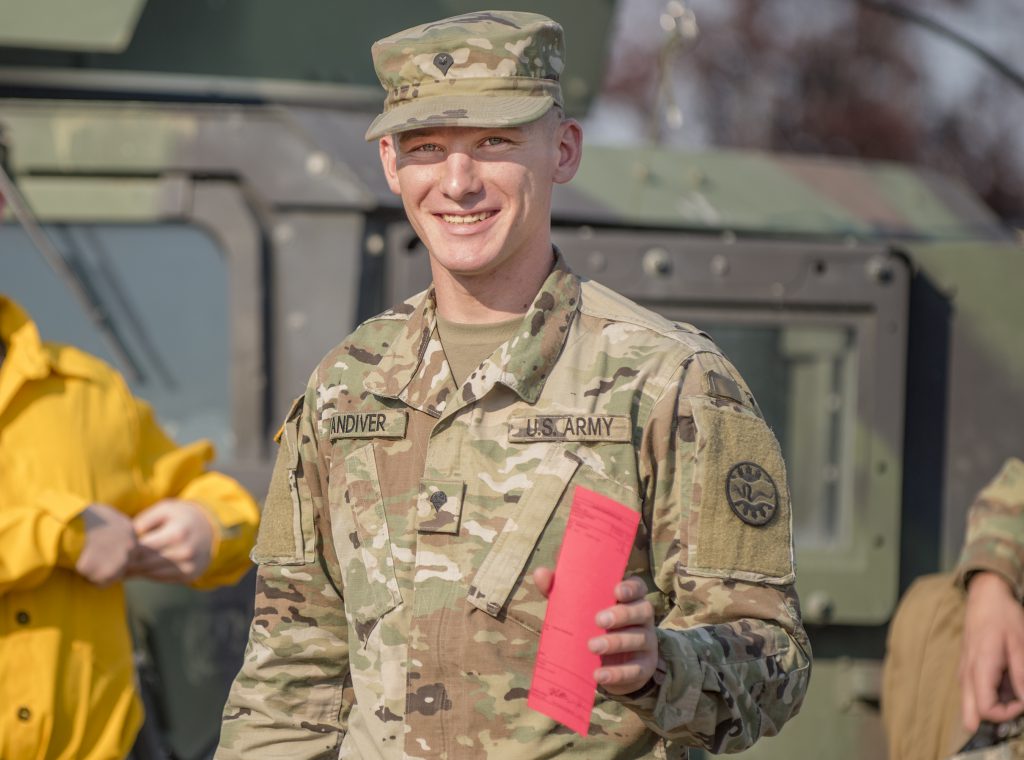
Idaho Military Division Public Affairs/Master Sgt. Becky Vanshur
Idaho National Guard Soldiers and Airmen made organizational history by sending wildland Firefighter Type 2 Red Card certified Guardsmen to northern Idaho to fight fires for the first time. The newly assigned crewmembers of the Task Force Timber Shield left Boise Aug. 4 to assist the Idaho Department of Lands’ mission of containing more than 15 significant wildland fires currently burning in Idaho.
It is the first time the IDL requested Idaho Gov. Brad Little to issue an emergency declaration for making Idaho National Guard resources available to assist fighting against fires on the ground. For some Guardsmen, the volunteer notice came early in July and they immediately began training to earn their FFT2 Incident Qualification Cards, commonly known as a Red Card certification.
“I made sure my name was on that list when I heard the call for volunteers,” said 2nd Lt. Travis Stice. “It will be hard, physical labor, which I am excited for. I told my son that I was going to leave to go fight fires and he said, ‘but you are in the Army, you’re not a firefighter,’ and I said, ‘We do everything, buddy.’”
Stice is one of 72 Guardsmen who has earned his Red Card and more personnel are currently completing the training in anticipation of additional missions. He joined the Idaho National Guard four years ago and this is his first State Active Duty mission as a Guardsman.
“I am very excited that this is a state mission,” Stice said. “It’s the reason I signed up for the Idaho National Guard, to help the citizens of Idaho, along with serving my country. I just love my fellow Idahoans. I called my employer with one day’s notice and they said ‘awesome, just come back safe and we’ll work everything out when you come back.’ They were very supportive even with the short notice.”
The additional training for more Red Card certified Guardsmen stemmed after the governor issued the emergency declaration July 9 to mobilize Idaho National Guard fire line FFT2 qualified personnel to work on active wildfire efforts on the 6.2 million acres of land across mostly northern Idaho where IDL provides fire protection.
The FFT2 crew consists of sixteen fully trained Idaho Guardsmen. The IDL provided one crew boss and two squad bosses to complete a full nineteen-man crew.
“We are currently training more Soldiers and Airmen as they volunteer for this mission in the hopes of building a large capacity consisting of several hand crews,” said Lt. Col. Tony Vincelli, commander of Task Force Timber Shield. “This is the kind of mission that makes serving in the National Guard so unique and rewarding. I hope Soldiers and Airmen see how rewarding this mission is and truly understand the impact they could have.”
The Guardsmen were issued firefighting personal protective equipment, fire-resistant clothing, hand tools and sleeping accommodations just prior to leaving.
“The boots on the ground, physical labor of this kind of work is different than anything I have ever done in my career,” said Maj. Robin Kiska, from the 224th Cyber Operations Squadron, Idaho Air National Guard. “It’s like an extreme hiking adventure in extreme conditions. It will be hard work but a welcomed challenge.”
The governor’s emergency declaration also authorized other personnel to support fire logistic activities and make National Guard aircraft resources available.
Currently, the Idaho National Guard has two UH-60 Black Hawk helicopters and pilots, crew chiefs, refueling crew and essential maintenance personnel assisting with aerial firefighting by delivering water using large capacity “Bambi Buckets,” or helicopter buckets, suspended from helicopter cables. The UH-60 Black Hawk crews have been assisting Idaho’s mission this fire season since July 13 and have dropped more than 187,096 gallons of water on several fires.
Additionally, a request for help at the Idaho Fire Cache warehouse in Coeur d’Alene sent eight Guardsmen on July 21 to provide logistical and operational support of daily refurbishment operation to include palletizing orders, building kits, cleaning, repackaging firefighting hoses and pulling stock of supplies and equipment for state and federal wildland firefighters.
The IDL, the Idaho Office of Emergency Management and the Idaho National Guard developed a partnership a few years ago through a Joint Powers Agreement, defining the process involved in interagency coordination, support, training and planning during times of emergency involving mutual aid of wildland fire relief within Idaho.
“Today marked yet another milestone in the proud history of the Idaho National Guard as wildland firefighter ground crews mobilized and deployed to support the growing wildland fire threats across our state,” said Brig. Gen. Russ Johnson, director of the Idaho National Guard Joint Staff. “Our National Guard service members – and their families – have again answered the call to support the citizens of Idaho during this volatile fire season.”
Currently, around the country more than 770 National Guard Soldiers and Airmen from eight states are assisting with fighting wildland fires. Four UH-60 Black Hawks, two CH-47 Chinooks and one UH-72 Lakota are supporting aviation wildfire operations across the nation. Four C-130 crews are in California, Nevada and Wyoming equipped with Modular Airborne Fire Fighting Systems. To date, National Guard MAFFS crews have made 357 drops and flown 366 sorties in support of the fires across the United States. The National Interagency Fire Center reports over 38,200 fires have burned a total of 3.2 million acres across 14 states.
Idaho Army National Guard participates in new smart weapon training
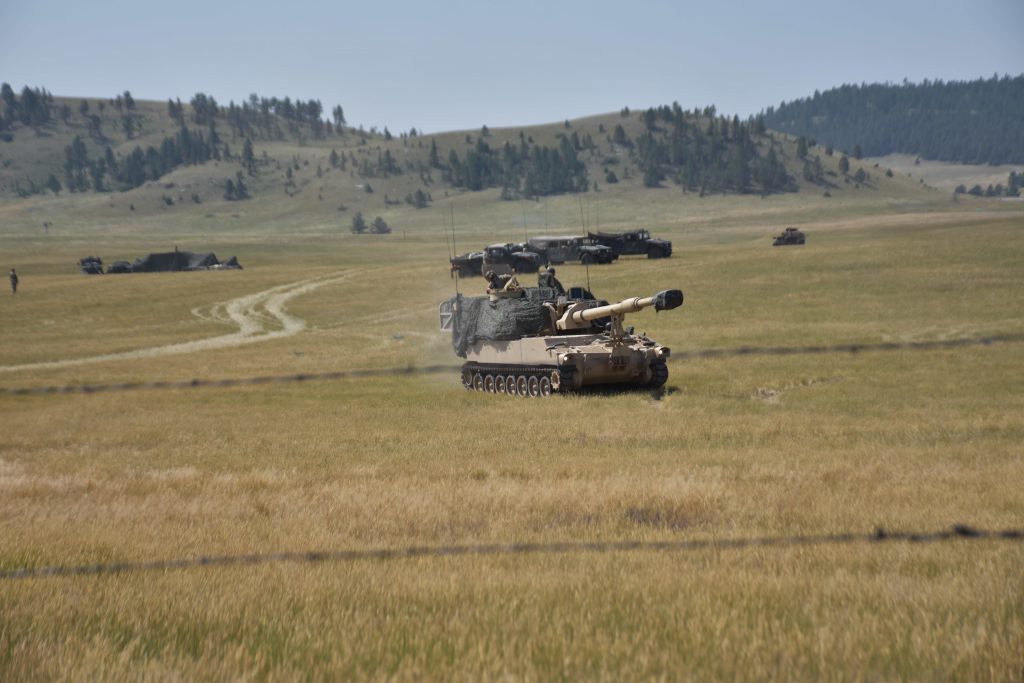
Idaho Military Division Public Affairs/Crystal Farris
The Idaho Army National Guard’s 1st Battalion of the 148th Field Artillery Regiment returned from its annual training July 24, after spending more than two weeks at Camp Guernsey, Wyoming, where it participated in its first M1156 Precision Guidance Kit new equipment training.
“Receiving the PGK NET was a great opportunity that will enhance the battalion and the 116th Cavalry Brigade Combat Team’s lethality on the battlefield,” said Lt. Col. Eric Orcutt, commander of the 1-148th FAR. “We purposely sought to field the PGK prior to the brigade’s upcoming mobilizations. If the PGK capability exists in the theater of operations we end up in, then our Soldiers will be trained to employ it and bring a precision capability to the fight.”
The GPS guidance kit with fuze functions and integrated GPS receiver, provides the 1-148th FAR with the latest technology to perform its warfighting mission and enables the unit to more accurately deploy munitions within 30 meters of an intended target, as opposed to the average 50 meters of traditional artillery.
Small aerodynamic fins on the fuze allow the system to make flight adjustments of the round’s trajectory and steer the shell on target. A fail safe can also prevent the shell from exploding if it falls outside 150 meters of an intended target.
This enables Soldiers to more confidently call in artillery support close to their position, reduce the number of shells needed to destroy a target and reduce difficulties in keeping crews supplied, said Sgt. 1st Class Mike Taylor, master gunner with the 1-148th FAR.
The fuze kit weighs three pounds and threads into the nose of conventional 155mm high explosive artillery shells, providing near-precision capabilities at a cost far less than precision munitions, Taylor added.
During the training, Soldiers belonging to Batteries Alpha, Bravo and Charlie learned about the PGK’s capabilities and conducted live-fire for the first time since the 1-148th FAR completed its National Training Center rotation at Fort Irwin, California, in 2019.
Orcutt said Camp Guernsey provided the battalion the ability to effectively train and conduct live-fire with more than 10 kilometers of open land.
“The 1-148 FAR was excited for the training at Camp Guernsey,” he said. “After last year’s annual training during COVID-19, everyone was eager to get back on the guns, on the hill, behind their fire direction computers, or wherever their job is. The training area was wooded, green, and full of terrain that many have not had an opportunity to experience, keeping the morale high and the training challenging.”
The 1-148th FAR employs fire to destroy, neutralize, suppress or shape enemy forces; provides fire support to maneuver in close combat and during counterattack to control land areas; and provides counterfire.
It is equipped with M1096A6 Paladins, self-propelled howitzers that fire 155mm artillery shells. Crews that operate the Paladin consist of four-man teams; a driver, a number one man, a gunner and a howitzer section chief.
The number one man is responsible for loading and firing the howitzer, the gunner fuzes the round and cuts propellant powder, while the section chief manages all firing data and ensures the howitzer is laid on target.
Challenge accepted: from Youth ChalleNGe to Soldier
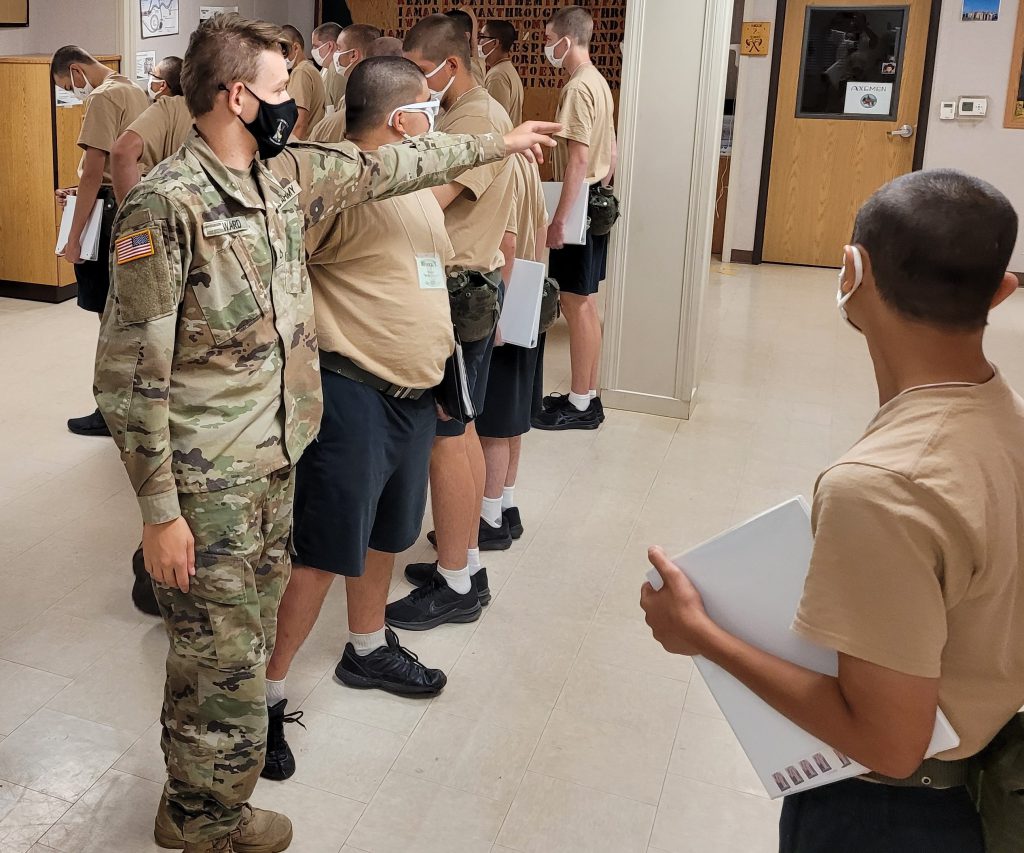
Idaho Military Division Public Affairs/Maj. Robert Taylor
The Idaho Youth Challenge Academy’s newest class of candidates is currently going through a two-week acclimation phase. During this phase, candidates are challenged to adapt to the program’s rigid schedule, strict rules and culture of personal accountability.
The academy conducts two classes each year. Idaho National Guard Soldiers and Airmen volunteer to supplement the academy’s full-time cadre to assist during its first phase in a state active duty status.
For most of the Soldiers and Airmen, this rotation is their first experience with the Youth ChalleNGe, though some Guardsmen have supported multiple acclimation periods at the academy.
For Pfc. Riley Ward, this semester’s rotation is his first as a cadre member, but he has extensive knowledge of the program’s goals and procedures. Ward graduated from the program as a cadet in 2018.
“When I graduated, I felt like it was just a matter of time before I came back in an U.S. Army uniform,” Ward said.
Ward enlisted into the Idaho Army National Guard in 2019 when he was 17. Though the academy offers cadets the chance to earn up to 14 high school credits; a diploma from the school; or a GED, Ward said he dropped out of high school shortly after returning home from the academy and earned his GED on his own.
Every cadet is paired with a mentor while they complete the 22-week residential phase. Ward’s mentor was Col. Dan Lister, the Idaho Army National Guard’s chief information officer and director of information management. Ward said Lister told him about the Idaho Army National Guard and the organization’s benefits.
“I liked the structure of the Youth ChalleNGe,” Ward said. “I figured it’d been stupid not to enlist since I thrived in that environment.”
Ward is a 25B information technology specialist assigned to Company Charlie, 116th Brigade Engineer Battalion. Ward lives in Nampa and drills in Boise at Gowen Field. Though Lister is the Idaho Army National Guard’s senior IT officer, it was Ward’s love of technology that drove him toward the same career field as his mentor.
“When I was six, my dad sat me in front of an old Windows computer, and I fell in love with technology then,” he said. “It’s always been a passion. I figured I might as well do something I enjoy while I’m in the Army.”
Ward said he has received a lot of training in his career field and that he’s never had a bad day in the Army. He plans to attend college and work his way up to his dream job: the head of network security for Dell Technology.
Ward said he attended the academy after a series of behavioral issues got him in trouble with his parents.
“I was a piece of crap to my parents, and they had enough, so they sent me here,” he said.
Ward acknowledged he was doing things at the time he shouldn’t have been doing, though he was never charged with any crimes.
“I learned discipline at the academy,” he said. “That’s all I really needed. I knew what the right thing to do was, I just didn’t feel like doing it. I realized to be successful, I couldn’t be in trouble with the law. These are basic things everyone knows, but I refused to do.”
Since 2014, more than 1,300 students from nearly every county in Idaho have attended the academy. The program is free for 16- to 18-year-old-students who are at risk of dropping out of high school or who already have. Cadets attend a 22-week residential program in Pierce, Idaho, and remain part of the program for the following 12 months to ensure students remain on track to continue their education or find employment.
There are 40 Youth ChalleNGe academies throughout the country, which are run by each state’s National Guard.
Nearly 80 percent of the Idaho Youth ChalleNGe Academy’s cadets return to their high school back on track to gradate with their class after completing the residential program. Another 10 percent earn their GED, while the remaining 10 percent earn enough credits to graduate from the academy with a high school diploma. Approximately 10 percent of the program’s graduates have joined the military, though the academy is not a military school and military service is not a requirement for attendance.
“Since I did exactly what they are doing now, I have a better feeling of what candidates are going through as they adjust to the academy,” Ward said. “A lot of them are coming off stuff and are in a new environment. I know exactly what that feels like. I feel more equipped to help them with whatever they need to do.”
Idaho National Guard memorializes WWII Medal of Honor recipient
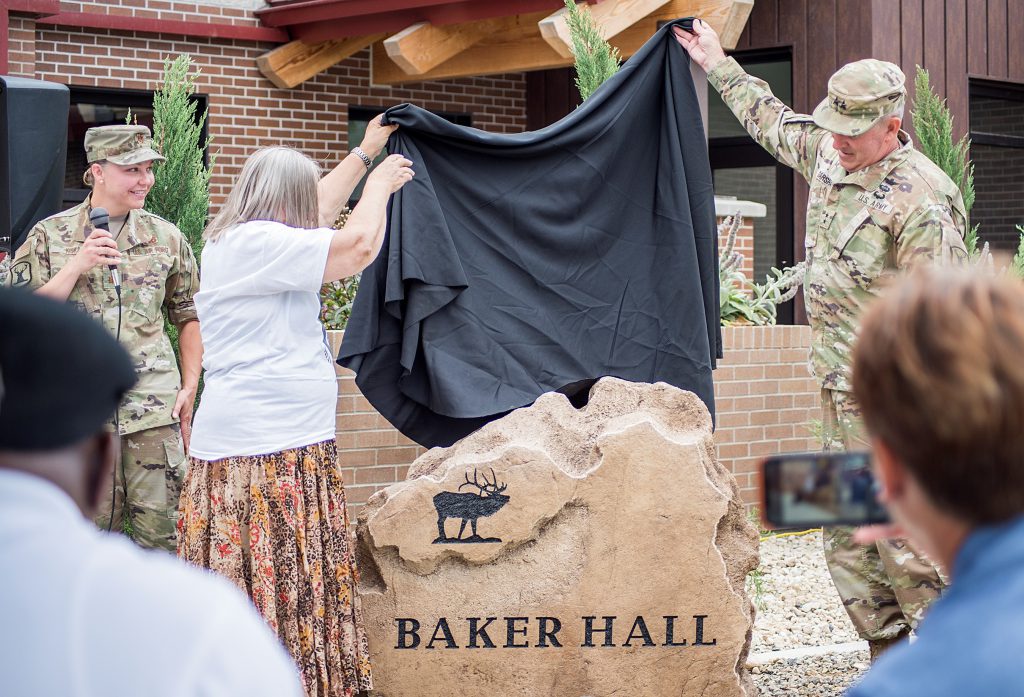
Idaho Military Division Public Affairs/Crystal Farris
The Idaho National Guard dedicated its newest barracks in honor of Medal of Honor recipient U.S. Army 1st Lt. Vernon Joseph Baker on Gowen Field, Tuesday.
Baker was one of seven African Americans awarded the Medal of Honor for service during World War II. He received the award nearly 50 years later for his extraordinary heroism on April 5 and 6, 1945, while in Viareggio, Italy. The award is the nation’s highest and most prestigious military decoration.
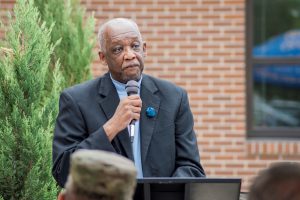 “I’m thankful that on this day, we will create a lasting legacy in the name of 1st Lt. Vernon J. Baker, Medal of Honor recipient,” said Jerome Mapp, former Boise City Council member and Caldwell planning and zoning director. “Those who will enter into this building will have the opportunity to learn about Baker, his leadership and the sacrifices he made.”
“I’m thankful that on this day, we will create a lasting legacy in the name of 1st Lt. Vernon J. Baker, Medal of Honor recipient,” said Jerome Mapp, former Boise City Council member and Caldwell planning and zoning director. “Those who will enter into this building will have the opportunity to learn about Baker, his leadership and the sacrifices he made.”
Baker joined the Army in 1941 and later attended Officer Candidate School to earn his commission as a second lieutenant in 1943. The following year, he deployed with the 92nd Infantry Division to Italy. On April 5, 1945, Baker led 25 African American infantrymen through a maze of German bunkers and machine gun nests to attack Castle Aghnolfi, a German stronghold.
He lost 17 of his men during the battle. However, Baker destroyed various enemy installations, personnel and equipment during the attack. The next night, he volunteered to continue the advancement of a battalion through further enemy minefields and heavy fire.
Baker earned the Distinguished Service Cross for his actions, the Army’s second-highest award for bravery.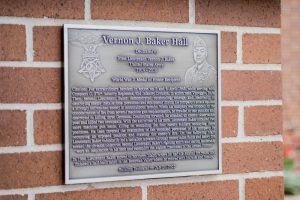
In the early 1990’s the Department of Defense and the U.S. Army initiated an investigation that determined a climate of racism had prevented African American service members from receiving proper recognition for acts of courage during World War II. In total, seven African Americans, including Baker, were later approved to receive the Medal of Honor.
Baker was the lone survivor of those seven individuals on Jan. 13, 1997, and the only African American to ever personally receive the award for service in World War II, when he accepted the Medal of Honor from President Bill Clinton at a ceremony in the White House. He was 77 at the time.
After Baker retired from the service in 1986, he moved to Idaho to pursue his love of hunting. He later met his wife Heidy, who he lived with in their St. Maries home until Baker’s death in 2010 when he was interred at the Arlington National Cemetery in Virginia.
Mapp said in 2020 he had wanted to recognize an African American from Idaho and remembered meeting Baker in 2000 during an event at the Idaho Black History Museum. Mapp thought Baker was worthy of recognition as an Idaho citizen and Medal of Honor recipient and requested he be memorialized by the Idaho National Guard.
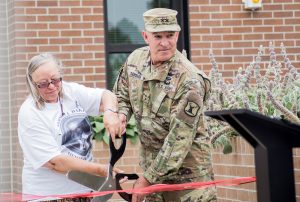 Maj. Gen. Michael Garshak, adjutant general of Idaho, said the organization wanted to honor Baker in a lasting way, where other service members could benefit from Baker’s accomplishments.
Maj. Gen. Michael Garshak, adjutant general of Idaho, said the organization wanted to honor Baker in a lasting way, where other service members could benefit from Baker’s accomplishments.
“Vernon Baker is a genuine American Hero,” said Garshak. “Not only for his heroic actions on the battlefield in World War II, for which he was awarded the Medal of Honor, but also because of his unfailing determination to put honor and country above all else.”
Construction of the barracks started in April 2020 and took three years and approximately $8 million to complete. It provides temporary lodging for up to 156 personnel with 39 private rooms and a shared dayroom.
It is the first building on Gowen Field to earn a gold certification in Leadership in Energy and Environmental Design; the second highest rating of four certifications that verify a facility’s green features. The Vernon J. Baker Hall earned its LEED rating through various features including integrated ground loop heating and cooling systems, low flow fixtures, sustainable building practices and sustainable landscape features.
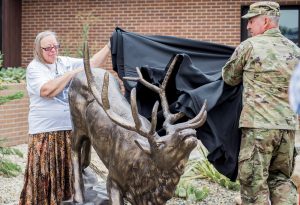 Heidy, who still lives in St. Maries, spent the night in the barracks prior to the dedication.
Heidy, who still lives in St. Maries, spent the night in the barracks prior to the dedication.
“It’s wonderful to have this building dedicated to my husband and a great honor for our family,” she said.
Outside the barracks is a stone that reads “Baker Hall,” a statue of an elk symbolizing Baker’s love for hunting in Idaho, and a plaque embedded into the bricks of the building entrance. Inside the building is his Medal of Honor citation and a brief history and biography of Baker.
We owe him everything we’ve got… and then some.
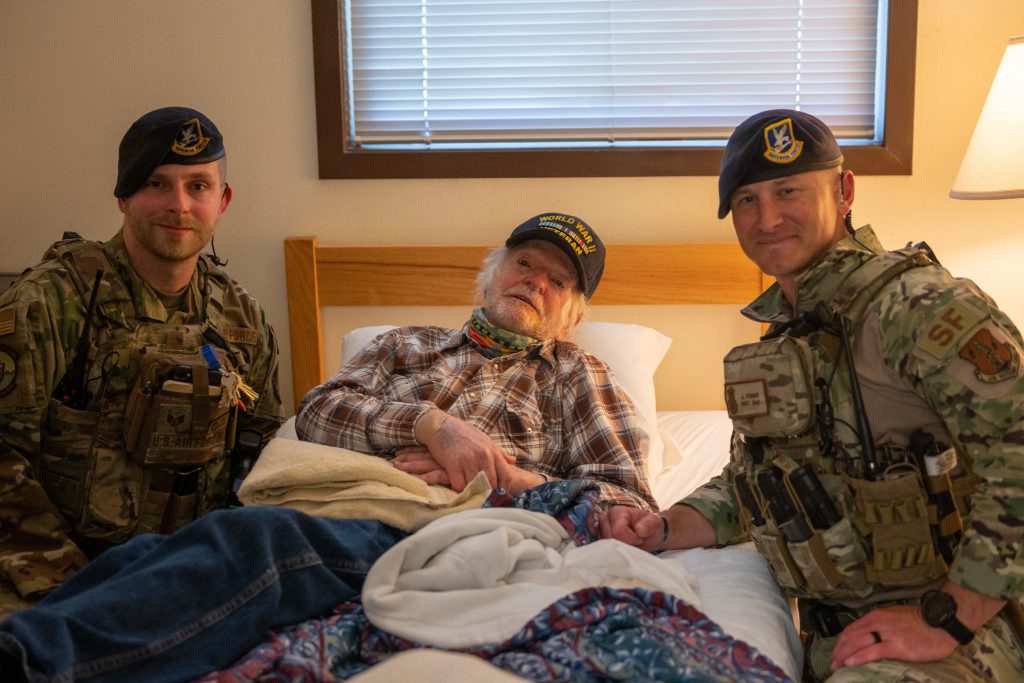
124th Fighter Wing Public Affairs/Staff. Sgt. Mercedee Wilds
124th Security Forces Squadron defenders went above and beyond to assist a 96-year-old World War II veteran.
Retired Capt. William Brand was a P-47 Thunderbolt pilot with the Eighth Air Force in Okinawa, Japan, during WWII. He now lives in Hailey, Idaho, but regularly travels to Gowen Field in Boise, Idaho to stay at the on-base lodging on days that he has appointments at the Boise VA Medical Center.
On May 6, 2021, 124th SFS defenders received an emergency call to the Gowen Field Lodging Facility. As Brand was checking in for a routine stay at the Gowen Field Lodging Facility he experienced a medical emergency, which left this WWII veteran with special requirements and a limited ability to properly care for himself and coordinate his VA appointments.
124th SFS defenders took it upon themselves to organize hourly shifts to check on the well-being of Brand, which included assisting with tasks of daily-living, providing essential needs and helping to coordinate with the VA for medical attention.
The defenders took on the role of dedicated care-givers, going beyond their typical duty and surpassing their daily requirements. To this group of 124th SFS members, it was an honor to help Brand and learn about his service to our country.
“Helping a veteran isn’t in our book for normal tasks, but it’s a sense of honor to help someone like that, who not only served our country but spent time in a war that we are still benefiting from,” said Staff Sgt. Jonathan Finer, a 124th SFS member.
Finer and the other defenders who helped Brand felt providing help and assistance to him, a brother in arms who dedicated so much of his life to protecting our country, was the least they could do.
“It’s an honor to be able to hear the stories from the direct mouth of someone who has experienced it,” said Finer, “my personal feelings are that we owe him everything we’ve got and then some.”
Youth summer camp, yeah!
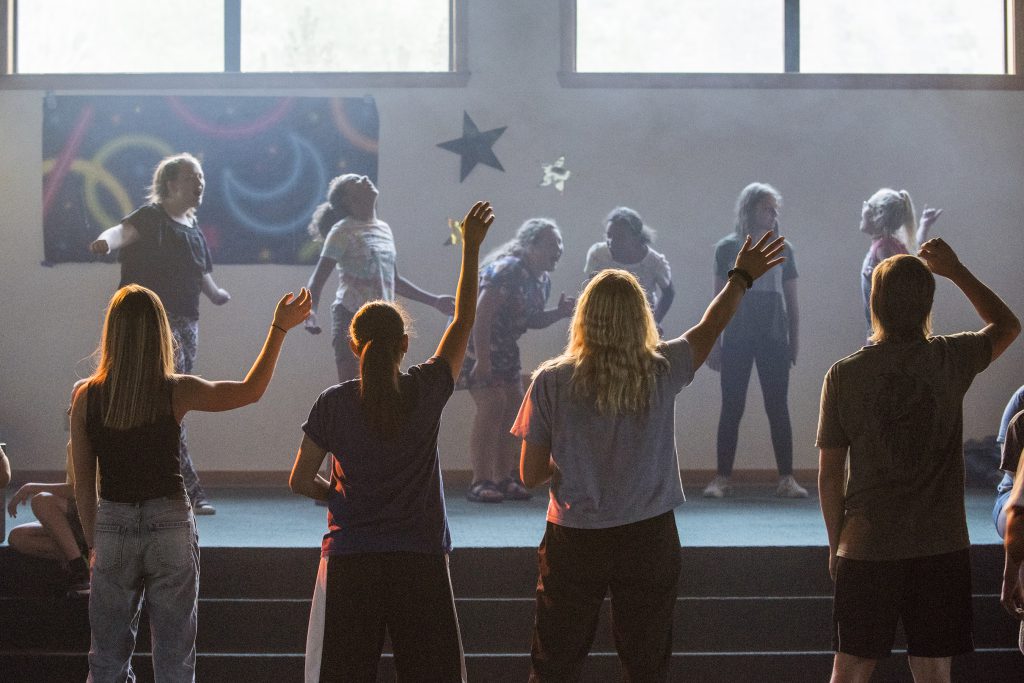
Idaho Military Division Public Affairs/Master Sgt. Becky Vanshur
The Idaho National Guard’s Service Member and Family Support held two Child and Youth Program summer camps in Challis, Idaho, during June. The annual camp took place over two weeks to accommodate COVID-19 protocols.
The camp was the first for military children ages 10 and up from around the state in more than 18 months. Youth from the Treasure Valley, Eastern Idaho and Northern Idaho joined together in Challis for a four-day, fun-filled camp that also taught them valuable lessons on friendship and resiliency.
“The camp is not just for fun, although it’s a ton of fun, but we also build resiliency training into our curriculum,” said Nick Wagner, Child and Youth Program coordinator. “This year in particular we focused on communication with the campers, because we haven’t had a camp for a year and a half and the youth may be struggling with that going back out into society after COVID. We wanted to bring that factor into this summer’s camp, to learn the communication needed to appropriately treat and respect our peers, opponents and our teammates.”
The Idaho National Guard has hosted summer and winter camps for more than 15 years and each year the coordinators work to continuously improve the program by closing each camp with a session that lets campers speak about what they liked or didn’t like about the camp.
“I like that you can always meet new friends and then you can see them at other camps or events,” said Ashton Danielson, a fourth-time camper whose dad serves in the Idaho Army National Guard at Gowen Field. “You’ll always have those friends but you can continue to meet new ones because if you see someone alone or that doesn’t have a friend, you go and include them. I like that about these camps.”
The program focuses on camp activities that help military youth grow, become more resilient and gain confidence. Each year they find more ways for activities to focus on the campers helping each other, motivating one another and working together while learning about sportsmanship, resiliency and coping with change during each challenge or activity.
Campers are broken into teams to allow for friendly competition and the sense of belonging to a group and working together for a common goal. They participate in events such vader ball, obstacle courses, archery tag, relay races, tug of war, 9-square, spike ball, yard games, basketball, volleyball, baseball and gaga ball. Additionally, campers were able to use their free time to create arts and crafts, make time capsules and learn 4-H activities with the Idaho National Guard’s College of Idaho 4-H partnership.
Campers also enjoyed a slip ‘n slide, performed campfire skits and had an end of camp dance party.
The camp continued to follow strict guidelines for COVID safety and protocol and held two camps broken down into smaller crowd numbers to accommodate these guidelines.
“We’ve had to get creative the past year and a half and come up with ways to reach out to our youth virtually,” said Wagner. “And this summer getting back into it, we had to break it into two camps to keep within the 50-person guidelines.”
During each camp, volunteers and chaperones ensure a safe and successful camp. Six teen counselors were present to help lead sessions, support resiliency, help make connections and provide positive influence for the youth. Wagner said the camp could not successfully run without the volunteers, teen counselors and chaperones.
“I have been coming to this camp as either a camper or volunteer for 15 years, for a total of 30 camps,” said Cloe Muthiora, a camp volunteer who was recognized recently with the 2020 National Guard Bureau Youth Development Volunteer Award for her time spent volunteering to the families of the Idaho National Guard. “I started coming when I was 10 and then came back as a chaperone once I was old enough and have been chaperoning ever since. This program is the reason I am who I am. I am a teacher now and I have leadership positions in other organizations because I grew up involved in this program, developing those skills. I started learning leadership skills when I was just 14, which gave me so many opportunities to explore who I wanted to be and become the best version of myself.”
The next camp will be the Winter Bash, held in January.
“Our Child and Youth Program is a great resource offered to military families,” said Command Sgt. Maj. Kevin Dean, Idaho Army National Guard senior enlisted leader. “I have been an advocate of this program ever since I had the pleasure of chaperoning a camp and that is when I came to fully support and promote this program. Whether it’s a summer camp, winter camp or a routine get together, this is a great opportunity for our kids to meet other military children who they can relate to with the struggles that sometimes comes with being a military kid compared to other kids in their community.”
Cancer can’t stop Guardsman from deploying
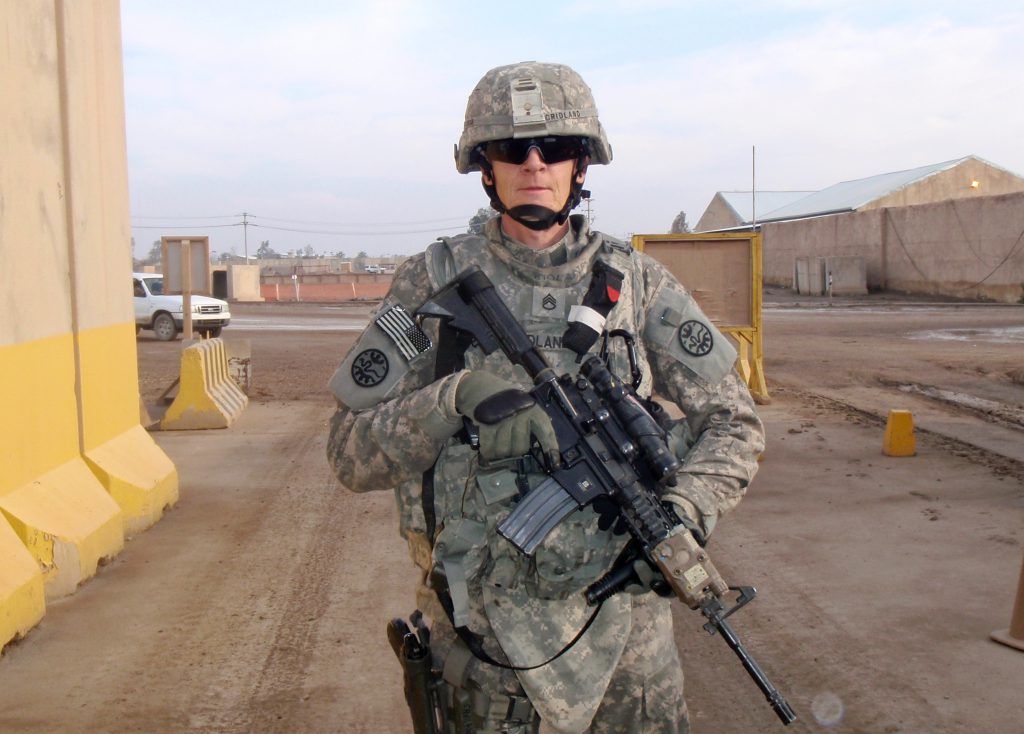
Idaho Military Division Public Affairs/Maj. Robert Taylor
Cassandra Cridland has known her husband, Sgt. 1st Class Wayne Cridland, since junior high.
“The thing to know about my husband is he’s just committed to life,” she said. “Whatever he’s doing in the moment, he’s fully committed to that. If he says he’s going to conquer something, you might as well stand out of his way. He’s going to do exactly that. Whether it’s cancer, going on a deployment or mowing the yard.”
Cridland was diagnosed with Stage 4A squamous cell carcinoma in February 2009. In September 2010, he deployed to Iraq with the Army National Guard’s 116th Cavalry Brigade Combat Team in support of Operation New Dawn.
“That’s what we train to do,” Cridland said. “As an NCO, I didn’t want another NCO leading my guys into combat and being responsible for them. If something happened to them, I didn’t want that responsibility on someone else’s shoulders who hadn’t spent a lot of time with them.”
Cridland said the cancer started in his left tonsil and then spread to the left side of his face, jaw, tongue and neck. His doctors proposed an aggressive treatment plan that gave Cridland an 85 percent chance of surviving. For eight weeks, Cridland was to receive radiation every day and chemo every Monday for five hours. Cridland said he had an IV port inserted into his heart to accept the chemo because the heart’s vessels are bigger than other blood vessels, which allows them to handle more damage from the chemo.
At seven weeks, Cridland said the treatment was causing him more harm than the cancer was, so his doctors had him take a week off. At that time, his chances of surviving dropped to 14 percent.
Cridland finished the last week of treatment in June and said he was given six months to live. He had shrunk in size from 190 pounds to 124 pounds while receiving treatment. He had a feeding tube for nearly three months because scar tissue from the radiation made it impossible for him to swallow. After it was removed, he had to learn to chew and swallow again. His doctor wasn’t sure he would be alive for Christmas. Cridland had other plans. He quickly went back to work and working out.
“I told him I didn’t have time for that and I was too dumb to die,” he said. “My wife absolutely wouldn’t let me quit. Every time I got down, my wife was there to remind me I had things to live for and keep me going.”
Cassandra said she deals with stress by walking and that while Cridland slept after treatment, she’d walk nine or 10 miles a day.
Cridland said he only missed drill once due to the cancer. He was hellbent on deploying with his unit, B Company, 145th Brigade Support Battalion, even as doctors told him they didn’t think it was possible.
“By the time he finished treatment, he needed something he could face head on,” Cassandra said. “He was completely out of control of the outcome of his treatment and he needed something he felt like he had some control over and I respected that. The deployment was something he needed. Doctors kept telling him he wasn’t going and he kept saying, ‘yes I am, just watch me.’”
Cridland said he argued with his doctors to clear him to deploy.
“I said, ‘if you can’t give me a medical reason why I can’t deploy, you need to deploy me.’ I think it was because I kept bugging them, they gave in and let me go. There was no medical reason for me not to go.”
Cridland deployed with the rest of the 116th Cavalry Brigade Combat Team in September 2010. The brigade trained at the Orchard Combat Training Center in Boise and at Camp Shelby, Mississippi, before deploying to Iraq.
ONE A SOLDIER, ALWAYS A SOLDIER
Cridland enlisted into the Idaho Army National Guard in 2007 as a 91B wheeled vehicle mechanic. He previously served in the U.S. Army from 1985 to 1991. After a divorce that left him with primary custody of three children under the age of five, he decided to get out of the Army. With his children grown and 9/11 still on his mind, he joined the National Guard.
“I’m from that age group where you don’t attack America and get away with it,” he said. “I was still young enough to come back in, so I reenlisted.”
Cridland was nearly 40 at the time. He said he showed up to the recruiting station with long hair and no one thought he was serious about enlisting until he produced his DD-214, indicating he had previously served.
“I like serving my country and knowing we’re making a difference,” he said. “In the National Guard, we can serve the public with snow removal, firefighting support and those type of missions, and we’re available for combat if we’re needed. A lot of it is just giving back to the community and supporting them when they need us.”
Cridland said the biggest difference between serving in the 80s and post-9/11 was the Army’s change of mission. Cridland was a mechanic for an infantry line unit during his first stint in the Army. He said training focused on defeating Russia in the Cold War. His mission in Iraq was largely convoy security and escorting VIPs in an urban environment.
Cridland was a squad leader during the deployment as his unit conducted more than 260 convoys along the 17-miles between Camp Victory and Baghdad’s Green Zone. For most missions, he was the convoy commander with 11 other Soldiers. He said most days were uneventful, with one exception.
On July 7, 2011, part of his team was hit by an IED, which claimed the lives of Specialists Nathan Byers and Nicholas Newby. The Soldiers were the brigade’s only two causalities during the deployment. Byers was 24. Newby was 20.
“I had known Byers for quite a few years,” he said. “That hit me hard. He was a good kid.”
Cridland, and the other part of his team, responded to the scene in just minutes to assist with fire support and security.
During the deployment, Cridland checked in monthly with the local aid station to have his throat inspected once a month to ensure the cancer hadn’t grown back. It still hasn’t grown back, though he lives with what he describes as low-grade pain all the time due to the damage the chemo caused his muscles and joints. His heart and lungs are both scared as a result as well.
Cridland’s two sons also deployed with his company. They were assigned different missions to prevent the family from being involved in the same mass casualty event. Cridland would see his oldest son, Michael, occasionally and his youngest son, James, fairly often as they were located at the same staging area.
While the three were deployed, Cridland’s daughter got engaged and planned her wedding for the day after her dad and brothers were scheduled to return home. Cassandra said she ended up having to delay the wedding by two hours but as soon as the three got home, they changed and Cridland walked his daughter down the aisle.
Cridland said it felt good to be home and that the loss of two Soldiers just weeks before still weighed heavily on his mind without any real closure. He took 45 days off and then went back to work.
‘THERE’S MORE HERE THAT I JUST HAVE TO DO’
Cridland said early into his diagnoses, he went to his company’s first sergeant and told him he had cancer and that he didn’t want to get out of the National Guard. Cridland doesn’t know what decisions were made at higher levels, but said his first sergeant and his unit fully supported him and his decision to deploy.
“As long as I was making progress, they kept working with me,” he said.
Cridland said since recovering from cancer and returning home from a deployment, he has become a lot more focused on his relationship with his wife and pursuing his goal to be promoted to first sergeant of the only company he’s served in since 2007.
Cridland met Cassandra in junior high. His now brother-in-law introduced the two because they were both in the school’s band and enjoyed reading. They became friends but didn’t start dating until 1993, after both had married and divorced other people.
“After three years, we decided we probably should just get married because we found a friendship and companionship that felt like a lasting thing and not something that is temporary,” he said. “We work really hard to get through things and not give up.”
“She kept me going. I didn’t want her to end up spending the next 30 to 40 years around without me around.”
After the deployment, Cridland took his wife to Scotland. The two hiked 138 miles in 12 days. He also found a job much closer to his home in Sandpoint, Idaho. He now works as a diesel mechanic for a local mining company. He had previously worked in Wyoming and traveled back and forth during the month.
“I don’t let things worry me as bad as they used to,” he said. “I use to have this since of urgency about everything, now I pick and choose what gives me that sense of urgency. I take things as they come now.”
He plans to stay in the National Guard for as long as he can. He’s currently 54 and could have retired two years ago, but as much as he enjoys his civilian job, he enjoys being around Soldiers more. He plans to deploy with the 116th Cavalry Brigade Combat Team in 2022.
He’s completed his military education and is his company’s combatives instructor and resilience trainer, efforts he’s made to learn as much as he can while he still serves.
“I had a college teacher who said once you have knowledge, no one can take it from you,” Cridland said. He said whenever you have the opportunity to learn something, you should learn it because then you own it and no one can take it.”
Cridland shares his story with members of his church whenever he can. He tells people not to give up when they are going through tough times. He tells people to keep fighting, knowing he’s made it through his worst days and is around to see his children have children.
“I’m not afraid to die, I just felt like there’s more here that I just have to do,” he said.
Idaho Guard partners in multi-agency all-hazards exercise
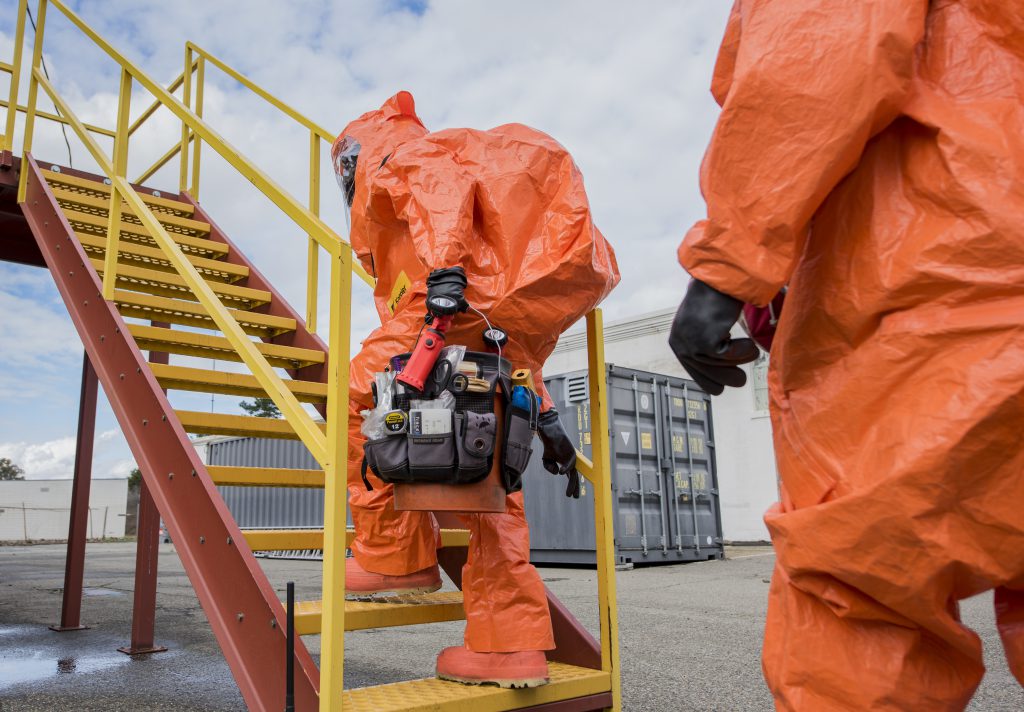
Crystal Farris/Idaho Military Division Public Affairs
The Idaho National Guard’s 101st Weapons of Mass Destruction Civil Support Team partnered with CSTs from 11 other states, along with more than ten different local and federal agencies and organizations, during Exercise ORCA 2021, to train in responding to various hazardous material incidents throughout Alaska, May 17 to 20.
The all-hazards exercise that took place simultaneously in Anchorage, Matanuska-Susitna Valley and Seward, involved the largest turnout of CST participants to an ORCA exercise, helping the 101st CST and other emergency responders maximize training opportunities while testing interagency coordination, interoperability and response abilities.
“It is important that we practice deployment operations and integration with other teams through exercises to ensure a rapid, timely and integrated response to a real-world threat,” said Capt. Jessica McBride, 101st CST survey team leader.
During the exercise, CSTs coordinated and worked through various scenarios, including identifying illicit and dangerous substances and responding to simulated attacks and disasters.
The 101st CST responded to the Anchorage Fire Training Center, which for the exercise simulated a residential six-story apartment building with approximately 20 rooms where terrorists prepared weapons of mass destruction.
“We were called in to conduct a relief-in-place of Alaska’s 103rd CST after it established perimeters with safe zones and threat zones, and then started site characterization of the building itself,” said Capt. John Bomsta, 101st CST operations officer. “We assisted in finishing the site characterization, describing what the building looked like and the possible threats we found. There was something to be found in every room and a lot of area to cover.”
Once on scene, the 101st CST worked through the night for approximately 12 hours continuing site characterization and field analysis of the building. During that time, it located five lab setups including a drug lab, a homemade explosives lab and a potential nerve agent lab. Rooms also had trips wires, motion detectors and confined spaces.
“We were able to provide field analysis of what we saw in the building in order to push information up to higher, which in this case was the FBI as incident command, on what they should look for at other sites,” said Bomsta. “As the story developed, other CSTs were located as far south as Seward, also responding to various terrorist threats in their vicinities.”
CSTs from Alaska, California, Connecticut, Colorado, Ohio, Oregon, Rhode Island, South Carolina, South Dakota, Washington and Wisconsin attended, in addition to other National Guard units such as Colorado’s 8th CBRN Enhanced Response Force-Package and members of Alaska’s 176th Civil Engineer Squadron.
Local agencies and organizations included Alaska Department of Homeland Security and Emergency Management, Matanuska-Susitna Emergency Management, Alaska Department of Environmental Conservation, Major Marine Tours, Alaska Railroad, Anchorage Fire Department, Alaska State Emergency Operations Center, University of Alaska-Anchorage, Port of Seward and the Port of Alaska-Anchorage.
“The exercise was designed with scenarios based on what all the participating CSTs had communicated they wanted to see and tasks they wanted to accomplish,” said Maj. Robert Grimes, 101st CST commander. “Our team was able to achieve various objectives, including integrating with other CSTs and civil responders to build those relationships and learn each other’s capabilities and limitations.”
Unlike most other military units, CSTs work almost entirely alongside civilian agencies, including regional hazardous response teams, police, firefighters and other state or federal responders that function under an incident command system during emergency situations. Grimes said developing these partnerships make training scenarios like Exercise ORCA 2021 critically important.
“What we do as an individual team is just one portion of what it takes overall to respond to a real-world event like this,” said Grimes. “We train to provide the best support we can to civil authorities in the event of a domestic chemical, biological, radiological or nuclear high-yield explosives incident.”
As one of 57 teams located in every U.S. state and territory, the 101st CST is composed of 22 highly skilled full-time Army and Air National Guardsmen trained to provide incident and disaster management by identifying CBRNE agents and substances, assessing current or projected consequences, advising on response measures and assisting with appropriate request for additional follow-on state and federal military forces.
As part of Idaho’s emergency response structure, the unit is prepared and ready to respond at any time to hazardous incidents that threaten the community, state and nation and are often called upon state-side to assist in public safety events including sports games and governor inaugurations.
 Official Government Website
Official Government Website